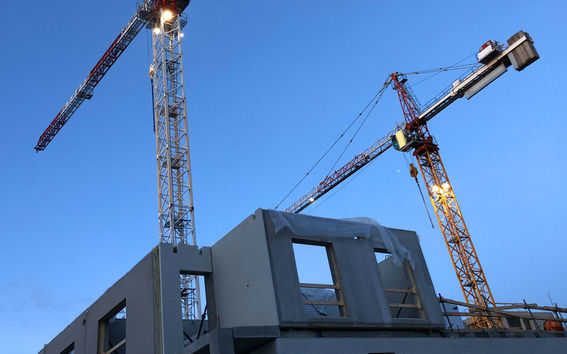DiCtion Strives for a Digital Quality Footprint That Supports Learning in Construction

DiCtion, Digitalizing Construction Workflows, is an Aalto University–led R&D project. It aims at a construction project in which digital data flow freely across processes and between participants. The project has developed a data model, an ontology, that makes data interoperable and enables automation. As a result, new opportunities for collaboration and shared use of data emerge.
One area where data sharing could create new value is quality management. Companies are typically quite myopic when it comes to quality management. They focus on their internal processes and collect data about them. They have little understanding of quality at the whole project level, leading to costly problems that repeat project after project. Companies deal with these issues reactively, with claims and mutual agreements.
DiCtion is now looking for ways to solve the predicament with data-driven project-level quality management, the digital quality footprint.
Introducing the digital quality footprint
DiCtion has studied the processes and data flows of precast concrete production extensively. The process involves a chain of several organizations, adding complexity to quality management.
The researchers have interviewed designers, a manufacturer, and general contractors. They have found that quality issues regarding prefabricated concrete panels and structural elements are often not evident until the installation at the construction site.
“We wondered if we should start developing practices that help manage quality deviations between participants,” said Professor Antti Peltokorpi of Aalto University. “The concept could materialize as a process and a quality database, an observation repository, that enables quality management between contributors and passes on learnings from one project to the next.”
The digital quality footprint could help the whole industry learn collectively. It would reveal, for example, which structures or design details pose a higher risk of failure than others. Furthermore, it could promote best practices and functional product specifications.
Quality issues are not equal
Markku Kiviniemi, a senior scientist at VTT, discussed two types of quality issues. First, there are obvious errors, for example, a missing reservation for an electrical outlet in a prefabricated structure. These lead to claims and monetary compensations. Second, a more frequent set of issues may not conclude in an official claim, but still has to be fixed. These are the deviations that DiCtion would especially want to collect and share between project participants. The target is to have self-learning feedback loops.
“In precast concrete construction, tolerances are vital. An interplay of tolerances can lead to a situation where a complex panel simply does not fit, and the design has to be revised,” Kiviniemi explained. “Another problem, which contractors have pointed out, is that the tolerances allow too much variation in panel surfaces. As a consequence, they require additional work for finishing. The cure would be to diminish tolerances.”
All companies interviewed by researchers had quite well-established quality management practices. Especially in manufacturing, quality assurance is an essential part of the production process. Quality observations are systematic, and organizations try to learn internally. However, that is not always enough.

Even noncritical issues are important to acknowledge
“I would argue that in many companies, quality systems and quality managers don’t or are not able to track grassroots problems.,” Kiviniemi noted. “The current digitalization trend can change this if we can track and share quality data for process improvement.”
Rita Lavikka, a researcher at VTT, underlined the need for better collaboration in projects. She explains that designers are interested to learn if and how their designs cause issues on the construction site. This kind of feedback is still rare, but collecting it would improve the performance of the whole industry at a systemic level.
The emerging data-driven construction provides a good starting point for automated collection of quality data. Fira, a contractor in the DiCtion consortium, exemplifies this development. It collects quality-related data systematically and is eager to include the whole supply chain in the process.
Transparency can be a challenge
The Finnish construction industry has been able to agree on certain common practices, and this willingness to cooperate could help establish the digital quality footprint. For example, one nationwide framework for jobsite safety has become a standard on Finnish construction sites. Construction company leaders are committed to it, which is one reason for its success.
Getting AEC firms to use a new system is not easy, especially when it focuses on matters that many participants would rather keep quiet.
Defining the digital quality footprint
Peltokorpi indicated that the quality issue data has to be anonymized so that it does not single out companies or projects. Only then can it be mined and used for shared learning. He drew a parallel to a medical databank that garners hazardous events.
Most of the current tools for construction data gathering are just an electronic equivalent of a paper form. They lack the context, which has to be defined manually. Therefore, the researchers suggest an automated classification of entries. The DiCtion ontology provides a good basis for this work.
“We need to establish incentives for those who we want to start collecting quality data,” said Lavikka. “In addition, the system should be simple; you should be able to take a snapshot, and the system would automatically link it to the location and the job to be done.”
The researchers are now prepared to suggest how the quality observations repository should be structured, what data to collect, and how to integrate the process with current construction practices. As a technical solution, they are testing how quality data can be linked with building information models and how to communicate them.
“All the time, we have to keep learning in mind. In addition to recording the issues, the system should allow us to identify causes and analyze them,” Peltokorpi concluded.
DiCtion: Digitalising construction workflows
The DiCtion project seeks to boost productivity of construction through the digitalisation of workflows.
Read more news

DeployAI Partners Gather for Heart Beat Meeting in Helsinki
The European DeployAI project's partners gathered for the Heart Beat meeting hosted by Aalto University Executive Education in Helsinki.
Get to know us: Associate Professor Maria Sammalkorpi
Sammalkorpi received her doctorate from Helsinki University of Technology 2004. After her defence, she has worked as a researcher at the Universities of Princeton, Yale and Aalto.
Aalto computer scientists in ICML 2024
Computer scientists in ICML 2024